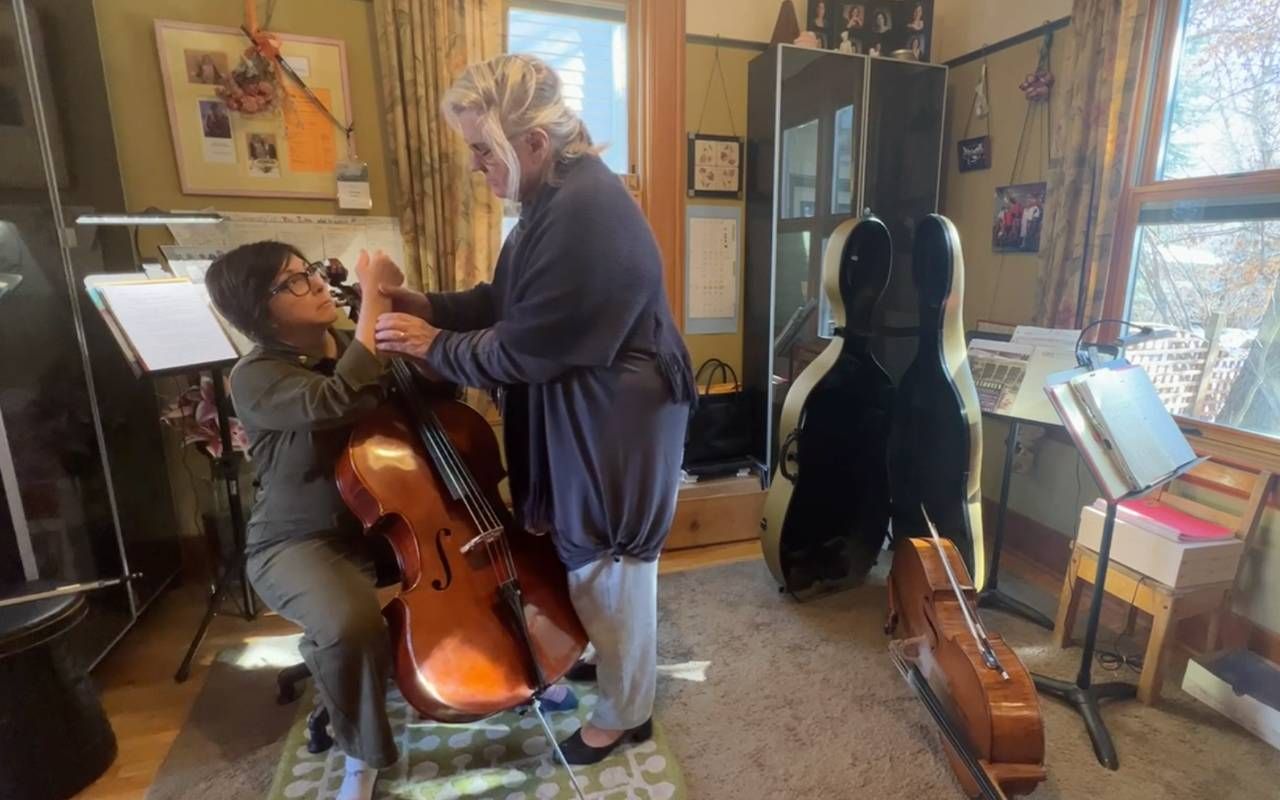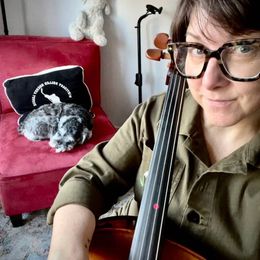Learning to Play the Cello at 50
Now that I am finally learning to speak the language of music, my cello and I are having some deep and vibrating conversations
On a three-hour road trip to the Rocky Mountains about ten years ago, with our young children asleep in the back, my husband and I made a bucket list. The list still lives in the Notes App on my phone. I visit it at least once a year and lately am reminded of the passing of time and all the items we have yet to check off.

We were on our way to knocking a few off the list in 2020 with a family trip to Europe (visit the Eiffel Tower in Paris, stay on a boat in Amsterdam), but the pandemic happened and that trip was canceled.
I loved going to see live music and was enthralled with watching the musicians play but it was easier to leave all the musical talent to the rest of my family.
On my fiftieth birthday, I revisited the list once again and decided that was the year I was going to check something off the list, starting with the one I could do for and by myself. Number 15. Learn to play the cello.
I don't know when I first fell in love with the cello. I have always been more attuned to the bass notes of any piece of music (and yes, the bass players of many rock bands). And after eight seasons of "Game of Thrones," where I insisted we listen to the full cello-based intro every episode, you get the point – those deep vibrating notes are my jam.
Convinced I Wasn't 'Musical'
It took me a long time to come to this decision, because over the years, I had convinced myself I wasn't "musical." I was someone who appreciated music but could never be a musician myself.
I loved going to see live music and was enthralled with watching the musicians play but it was easier to leave all the musical talent to the rest of my family: My husband, a Royal Conservatory of Music Piano graduate with perfect pitch, my son, the naturally gifted classical guitarist, and my daughter, the dancer with extraordinary musicality.
I was simply the chauffeur for practices and lessons and their most enthusiastic fan at recitals and performances.
At the beginning of 2023, in a fit of "I don't give a damn anymore" that comes with age, I finally made both the commitment and the investment. I bought a used cello from a friend who was upgrading her instrument and who also hooked me up with her cello teacher. In March of 2023, I started taking lessons from Victoria Clarke, who is 20 years older than me and has been teaching cello since the 1980s.
The Music Studio
Victoria's studio is in her home, a two-story Victorian-style house in a hilly neighborhood. She leaves the front door unlocked and students are told to just come in, say hello to Annie, her black standard poodle, take off their shoes and then enter the studio.
Unlike my belief about musical talent, Suzuki believed that one's musical ability is not innate; it's a skill that can develop with careful nurturing and training.
The studio itself has two adjoining rooms: A sitting area, where cello cases and coats and bags are left and the teaching area, with an upright piano in one corner, Victoria's personal cello - a 100-year-old instrument that emits the most gorgeous sound - in another, and the student area on a square carpet in the middle.
The walls are covered in photos of old students, dried bouquets she has received and yellowed newspaper clippings of past performances. On various hooks around the walls are her collection of laminated teaching booklets and visual tools which she tells me are for her four-year-old students, but then also uses with me.
Victoria teaches using the Suzuki Method, a music teaching system developed by the Japanese violinist and educator Shinichi Suzuki (1898-1998). The essentials of the Suzuki method are an early beginning, parental participation, and rote learning and repetition. At least I have that last one, what with being the parent of two teenagers and therefore an expert at repeating myself.
Unlike my belief about musical talent, Suzuki believed that one's musical ability is not innate; it's a skill that can develop with careful nurturing and training. He likened it to how children learn to speak languages through listening, imitation and repetition.
He even called it "The Mother Tongue Method." In essence, start them young and develop both their physical muscle memory with their instruments and their auditory memory of the "language" of music. Only then do students progress to learning how to read the music being played.
My very first cello lesson was 45 minutes of learning how to hold the bow. We didn't even touch the cello. Ten months later, Victoria still spends a good 10 minutes of our lesson correcting or perfecting my bow hold or making me play one note over and over until she is happy with both my bow hold and my sound. My fifty-two-year-old muscles are taking longer to establish some of that memory!
Building Skills and Stamina
At the beginning, my fingers and wrists would ache afterwards, and I would get home some afternoons and immediately warm up a heat pack for my neck and arm. I texted my cellist friend to ask if the soreness would go away and she assured me it would, eventually. I now have a new appreciation not only for the talent, but also the physical stamina required to be an orchestra musician playing long pieces of music.
Playing the cello, or any string instrument, is not like any other. There are no black and white keys like on a piano telling you what the notes are. No frets on the neck of the cello to guide you like on a guitar. You have to train yourself to hear the notes and feel them with your string hand and know when you are hitting the sweet spot.
My years of being an enthusiastic listener and appreciator of music have paid off, because according to Victoria, I have a very good ear. Suzuki – and Victoria – insist on students listening to the music they are learning to play as much as possible. I found a playlist of all the songs in the Suzuki Cello Volume One booklet and played it so much that many of them showed up on my Spotify Wrapped list for 2023.
My goals for 2024 are to learn and perfect the cello vibrato, find a contemporary song to duet with my son on guitar, and join Victoria's other students for the end of year performance and ensemble in June.
My cello rests on a stand in my bedroom and I practice in front of the windows looking out on our front street. If I leave the cello in its case, I tend to forget about it, and then my son, giddy with years of payback, likes to nag me about practicing.
My biggest fan is, of course, my dog. She follows me into the room when it's time to practice and lays on our bed while I warm up my fingers and serenade her to sleep with variations of "Twinkle Twinkle Little Star."
I wrapped up lessons in December having almost completed the first song book of the Suzuki Cello series. I'm working on the last piece in the book, Minuet No. 2 by Johann Sebastian Bach. My goals for 2024 are to learn and perfect the cello vibrato, find a contemporary song to duet with my son on guitar, and join Victoria's other students for the end of year performance and ensemble in June.
Learning the cello at my age has been challenging, but not impossible. I think Suzuki's methods work because, while I haven't been playing music my whole life and didn't learn it as a mother tongue, music itself has been a language I have always loved and has loved me back.
Now that I am learning to speak it, we are starting to have the most gorgeous, deep, vibrating conversations!


